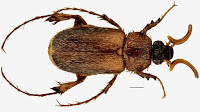Mexico has an essentially
tropical climate, but is crossed by a series of volcanic mountain
ranges, formed largely by the subduction of part of the Cocos Plate
beneath the southern tip of the North American Plate. These
mountains, on their upper reaches, bring temperate climatic
conditions far south into the Mexican tropical zone, providing a
bridge for fauna and flora between the temperate climate of North
America and the tropical climate of Central America. The formation of
these mountains has occurred in four main stages over the past
nineteen million years, with areas of different climates forming,
bcoming isolated then merging numerous times, leading to the
evolution of a very large number of endemic species, and making
Mexico one of the world's most important biodiversity hotspots,
In a paper published in the journal ZooKeys on 15 March 2016, Victor Moctezuma of the Red de
Ecoetología at the Instituto de Ecología, Michele
Rossini of the Dipartimento di Scienze Biomolecolari at the
Università di Urbino Carlo Bo and the Departamento de Biologia e
Zoologia at the Universidade Federal de Mato Grosso, Mario Zunino of
the Dipartimento di Scienze della Terra, della Vita e dell’Ambiente
at the Università di Urbino Carlo Bo, and Gonzalo Halffter, also of
the Red de
Ecoetología at the Instituto de Ecología, describe two new species of Scarab Beetles from the
Trans-Mexican Volcanic Belt, a range of mountians running east to
west across southern Mexico. Both species are placed in the genus
Onthophagus,
and were collected in the westernmost part of the eastern sector of
the mountains.
The
first new species described is named Onthophagus
clavijeroi, in
honour of the eighteenth centuary Mexican biologist Francisco Xavier
Clavijero. The species is described from six male and two female
specimens captured in traps bated with dung at altitudes of between
2543 and 2710 m above sea level on Mount El Pinal in Puebla State.
These are dark brown Beetles covered in light yellow hairs, with the
largest males reaching 9.4 mm in length. The females are slightly
smaller than the large males, however the species appears to possess
two male morphologies, with smaller males roughly the same size as
the females.
Onthophagus
clavijeroi,
major male. Moctezuma et
al. (2016).
The
second new species described is named Onthophagus
martinpierai, in
honour of the twentieth century Spanish entomologist and ecologist
Fermín Martín Piera. This species is described from 15 male and 36
female specimens collected in traps bated with dung at altitudes of
between 2530 and 2742 m above sea level on Mount El Pinal in Puebla
State. These are dull-to-silky black Scarab Beetles with a copper
cast in places, reaching about 5 mm in length.
Onthophagus
martinpierai,
major male. Moctezuma et
al. (2016).
See also...
 Ateuchus cujuchi: A new species of Scarab Beetle from Rodent burrows in Bolivia. Tuco-tucos, Ctenomys spp.,
are small South American Rodents which live their entire lives underground
within underground burrow systems, never venturing to the surface. Studies of
other Rodents with similar...
Ateuchus cujuchi: A new species of Scarab Beetle from Rodent burrows in Bolivia. Tuco-tucos, Ctenomys spp.,
are small South American Rodents which live their entire lives underground
within underground burrow systems, never venturing to the surface. Studies of
other Rodents with similar...
There are currently eight species of Scarab
Beetles in the genus Scapanoclypeus,
which is known from Namibia and western South Africa. They are...
 A new species of Scarab Beetle from the Elandsberg Mountains of the Western Cape, South Africa. Scarab Beetles of the genus Trichostetha occur across southern Africa, reaching their greatest diversity in...
A new species of Scarab Beetle from the Elandsberg Mountains of the Western Cape, South Africa. Scarab Beetles of the genus Trichostetha occur across southern Africa, reaching their greatest diversity in...
Follow Sciency Thoughts on Facebook.



